Our busy lives have made reading a physical book nearly impossible. Although we have enough eBooks on the market, it also requires some effort and time to be invested. Because of this, the development of the audiobook market per year is found to be 30%.
With busy schedules, people love the convenience of listening to captivating stories or learning something new while commuting, cooking, or working out. And here's the good news: creating an audiobook isn't as complicated as you might think.
So, if you're an aspiring author, a content creator, or just curious about how to make an audiobook with your own voice, this guide will break it down step by step. We'll show you how to create an audiobook that people will love listening to—no stress, no fuss!
In this article
Part 1. What You Need to Create an Audiobook
Making an audiobook is all about having the right tools and a few essential ingredients. So if you want to create an audiobook, here's what you'll need to get started:
- A Good Narrator: The voice makes all the difference. You can narrate it yourself or hire someone who matches the mood of your book.
- An Engaging Story: This is the most important part. Your story needs to grab the listener's attention and keep them hooked.
- Proper Recording Equipment: For clear, professional sound, use a good microphone (not your laptop or phone mic), a pop filter to reduce extra noise, and headphones to check the audio as you go.
- Reliable Recording and Editing Software: You'll need software to record and clean up your audio. This is where you fix mistakes, remove background noise, and make everything sound smooth.
But here's the thing—what really matters most is having a great story. The rest can be sorted out with the right tools. For example, editing software like Wondershare Filmora makes the whole process easier. It uses AI to clean up background noise, balance your audio, and save you a ton of time—even if you're new to this.
Part 2. How to Create an Audiobook Effortlessly?
Now that you know what you need, let's talk about how to actually create your audiobook without all the stress. Like we mentioned above, Filmora has everything you need to get the job done quickly and professionally.
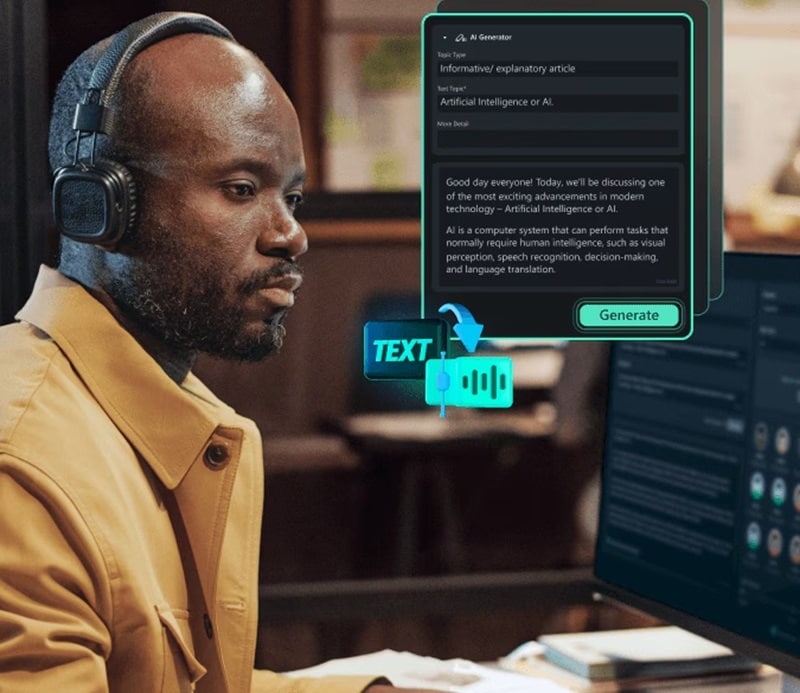
Here's how Filmora makes creating an audiobook effortless:
- Built-in Recorder: You can record your voiceover directly in the software, so there's no need for extra apps or tools.
- AI Voice Cloning: Create a custom AI voice by cloning your own voice. This way, you can make your audiobook sound exactly like you, without having to record every single word.
- AI Text-to-Speech: Use AI to narrate your story with a range of natural-sounding voices if you prefer not to record yourself.
- Speech-to-Text: Automatically generate captions for your audiobook if you want to offer a text version alongside the audio.
- Audio Enhancement: Clean up background noise, balance the sound, and make your audiobook sound like it was recorded in a professional studio.
- Translation Tools: Expand your audience by converting your audiobook into multiple languages quickly and easily.
With features like these, you can create a professional audiobook without needing expensive equipment or tons of editing skills. The best part is, that Filmora provides all these tools at a reasonable price. With flexible pricing plans and a free trial, you can explore everything it offers before deciding to buy or subscribe.
To learn how to make an audiobook using Filmora's AI, follow this simple guide:
Step 1 Launch Filmora and start a new project
Download and install the latest version of Filmora on your device if you haven't done so already. Then, open the program and click on "New Project" to access the main editing interface, where you'll create and edit your audiobook.
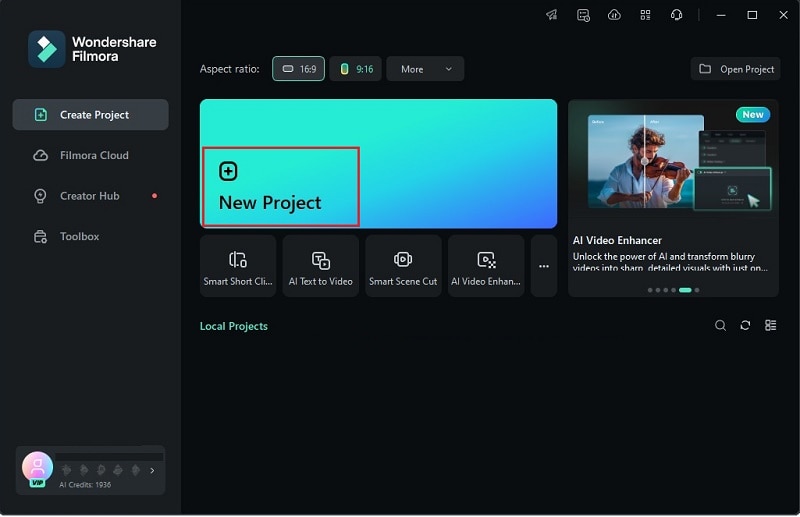
Step 2 Access the Text-to-Speech tool
Click on "Audio" in the top menu bar, then select "Text-to-Speech" from the dropdown menu. To start using the feature, simply click "Start".
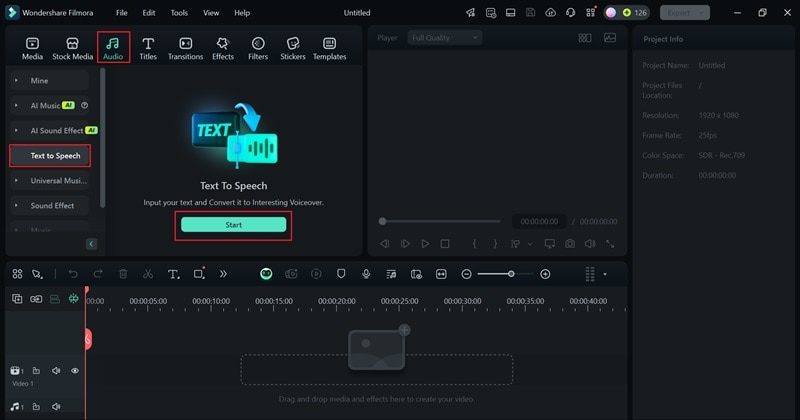
Step 3 Write your text and generate the audio
Paste or type your text into the description box, and Filmora will split it into sections for smoother narration. Then, select the audio language and choose from a variety of AI voice options, like male, female, or regional accents, to match your story's tone.
If you'd like to create a custom AI voice that matches your own, you can do that too! But to make this happen, you'll need to record your voice and give consent for the tool to be used for cloning.
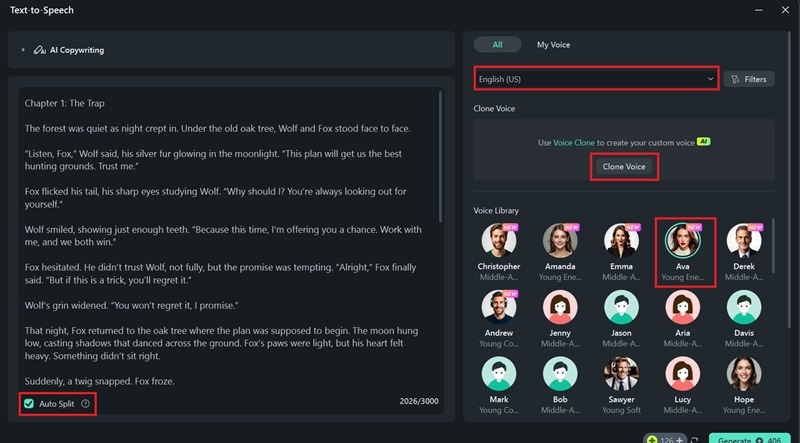
If you scroll down, you can also tweak the speed and pitch of the voice by adjusting the sliders to your liking. Once everything looks good and matches your preferences, click "Generate" to create the audio.
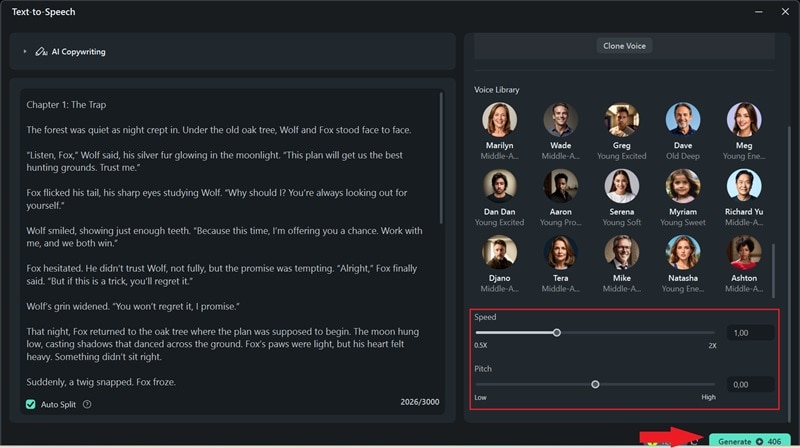
Step 4 Edit the audio (optional)
Once the generation is complete, your audio will automatically appear on the timeline. You can adjust the volume and other audio settings in the property panel on the right.
To make your audiobook more immersive, you can add sound effects. Simply go to the "Audio" tab, select "Sound Effect", and browse through the available categories. Choose the effect you like and drag it onto the timeline where it best fits the scene.
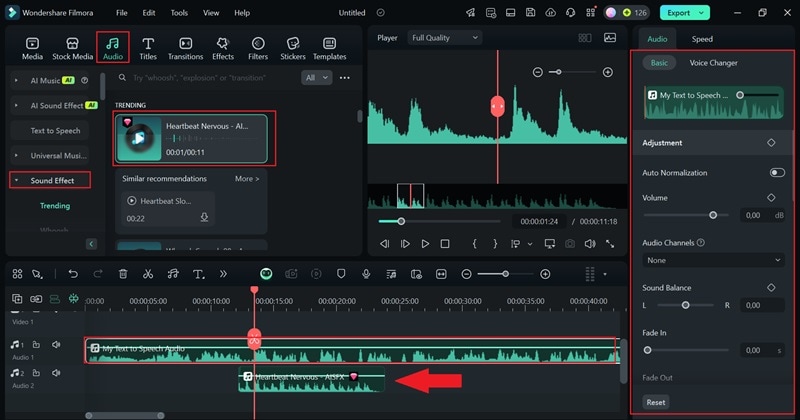
Step 5 Save your audiobook
When you're satisfied with your audiobook, click "Export" in the top-right corner. Select "Local" to save it to your device, and set the format to "MP3". Finally, click "Export" again, and that's it—your audiobook is ready to share on any platform!
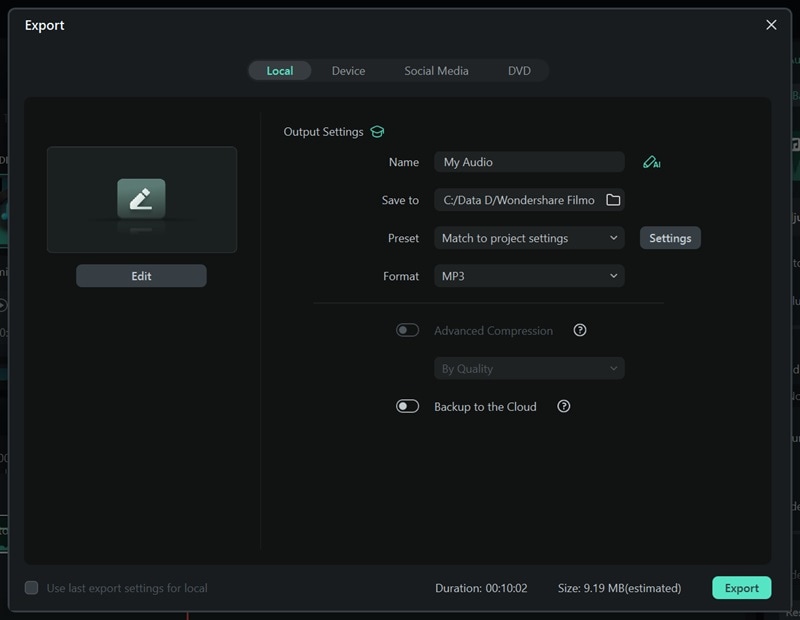
Part 3. How to Record Manually for Making Audiobooks
As you can see for yourself, Filmora makes creating an audiobook simple with its Text-to-Speech tools using AI voice. But if you'd rather have full control over your audiobook's narration, you can record it manually.
Filmora makes this process easy too, though it does take a bit more effort. The good thing is, that recording your own voice means you can decide the tone, pacing, and emotion of every word and sentence—making the story sound exactly how you want it.
To learn how to make an audiobook by recording manually in Filmora, you can follow this simple guide:
Step 1 Open Filmora and record your narration
After opening Filmora, head to the "Media" tab and click on the "Record" option. From the dropdown menu, choose "Record Voiceover".
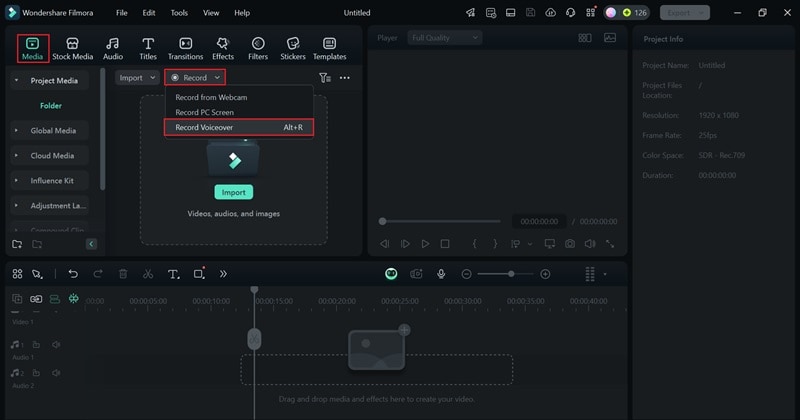
A window will pop up asking where you want to save your audio—pick a location on your device. Then, hit the red record button, wait for the 3-second countdown, and start your narration.
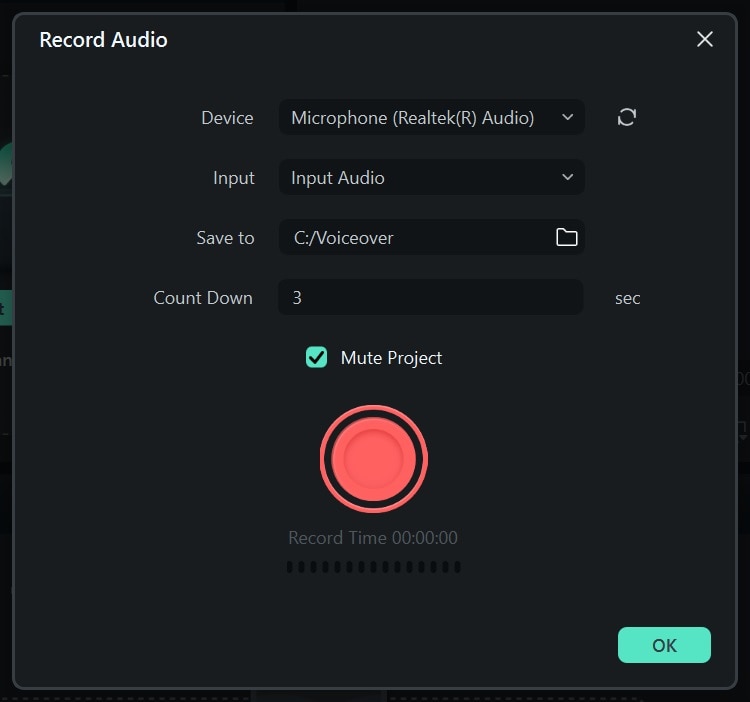
Step 2 Edit and export your audio
When you're done with your narration, click the red button again to stop recording. Your audio will automatically appear on the timeline. You can adjust the volume and other audio settings using the property panel on the right. Just like previously, you can make your audiobook more engaging by adding sound effects.
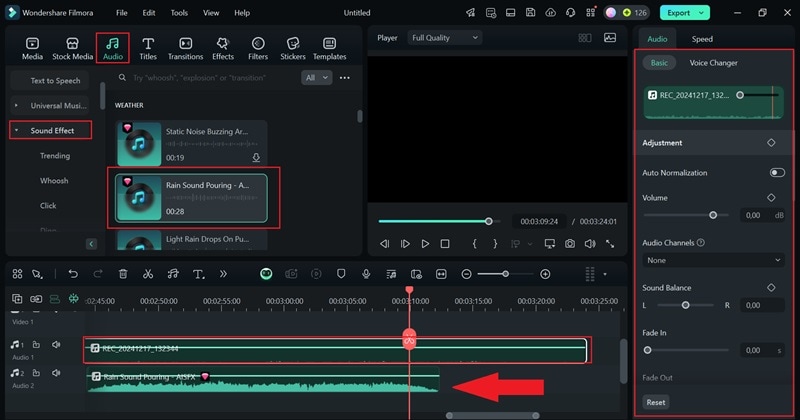
If you want to change how your narration sounds, it's possible! Just go to the "Voice Changer" menu in the property panel and select "Voice Character". Click the download icon on the voice you like, and it'll be applied to your audio automatically. Once you're happy with it, click "Export" in the top-right corner to save the audio to your device.
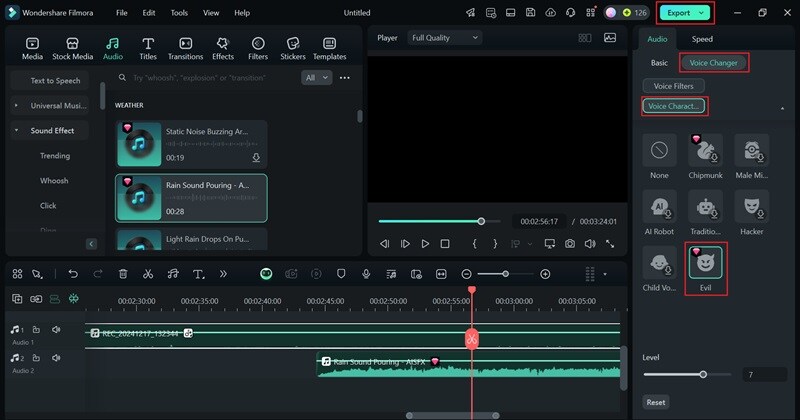
Watch the video tutorial below to fully master this process!
Part 4. Share and Promote Your Audiobook
Now that you've finished making an audiobook, it's time to get it out into the world! Sharing and promoting it is just as important as creating it, and luckily, there are plenty of platforms to help you reach listeners and even earn from your hard work. Here's where to start:
- Audible: One of the largest platforms for audiobooks. Use Amazon's ACX to publish your audiobook, reach listeners worldwide, and earn royalties with every sale.

- Apple Books: This platform provides a great way to share your audiobook with millions of iPhone, iPad, and Mac users around the world.

- Spotify: Spotify isn't just for music anymore. Upload your audiobook here to connect with listeners who already use the app daily.

- Social Media: Share short audio clips, behind-the-scenes moments, or mini trailers on Instagram, TikTok, Facebook, and YouTube. It's a fun way to grab attention and get people interested in the full audiobook.

Conclusion
The audiobook market is growing by 30% every year, making it the perfect time for aspiring authors, content creators, or anyone curious about making an audiobook to jump in. So, this guide provided different ways to learn how to make an audiobook using the powerful video editor, Wondershare Filmora.
Filmora makes it easy to create an audiobook just the way you want. If you need a quick option, the AI Text-to-Speech feature lets you use AI voices or clone your own for a personal touch. If you prefer to record it yourself, Filmora's built-in recorder lets you add your own tone and emotion to every word.
Once you're done, you can edit the audio, add sound effects, and even translate it into different languages to share with listeners around the world.



 100% Security Verified | No Subscription Required | No Malware
100% Security Verified | No Subscription Required | No Malware

